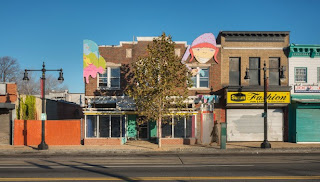It is safe to say that social media has changed the world. Never
before have we been in instant contact with people from every country and
continent. We receive up-to-date check-ins from our friends and family and also
complete and utter strangers. It is no surprise then, that this ability to
communicate with just about anyone has lead to the revolutionary idea of fundraising.
What might be more surprising is that social media has helped reinvigorate
local communities by allowing them the power to create their ideal city.
Okay, sure, technically fundraising is not revolutionary. It has
been around since the invention of financing, but the idea of raising capital
from private investors you have never met is pretty far-fetched. Welcome to the
world of crowdfunding. We’ve all heard of it. Crowdfunding is being used to
invest in emerging entrepreneurs in developing countries and that videogame/movie/iphone
app you read about on Kickstarter. There are a slew of websites out there that
can help anyone raise money for anything. Even a skyscraper.
 |
| Botoga's crowdfunded skyscraper source: Plantizen.com |
Crowdfunding for urban development is well on its way to catching
on like pocketbook wildfire. Private investments are no longer just the
wealthy, the 1%. In Bogota, Columbia the first urban crowdfunding project
successfully raised $239 million for a 66-story skyscraper, with the help of 3,100
private Columbian investors. The public now owns a portion of the new building.
They have taken an interest and invested in their city’s future, their future,
and their children’s future. This adds a whole new meaning to community
involvement. Seeing the enormous success of a project of this magnitude begs
the question, “What else can we fund as a community?”
Websites tailored to community and public space projects are
already creating platforms to raise money. Spacehive, Citizinvestor and
Patronhood have tapped into civic crowdfunding for local communities. Fundrise
is currently helping Washington D.C raise funds for an urban development
project along their H Street Corridor. So what can we fund next? Is a public
park possible? How about a bike share program? Could a whole BRT line be
publicly funded? The answer is, it
depends.
 |
| Fundrise's H Street Corridor Project Source: West Mill Capital |
Crowdfunding has been successful partly because of its simple and
forward ask. I want to create/make/build X and I need X amount of money to do
it. As of April 2012, the rules for funding changed. The future of crowdfunding
is about to become more complex and difficult to navigate. The difficulty comes
from the signing of the Jumpstart Our Business Startups (Jobs) Act by U.S
Congress. Crowdfunding is now regulated with much harsher and onerous regulations.
“It puts big deal procedures and liability on small deals.” These new regulations
could potentially result in expenses as high as 20% on any transaction, versus
8% for other standard investments. “The JOBS Act creates several procedural
hurdles that are not economically consistent with small capital raises”, one
attorney looking into public funding mentions, “ this lays the riskiest
investments at the doorstep of those investors that can least afford the risk”.
While these hurdles do seem to be creating
potential issues for the basic ideals of public funding, I believe that the spirit
of community organizing will survive. It always has. The legal issues
surrounding the JOBS Act are still speculative and hard to measure. No one
knows what will happen ones the act is placed in motion. Some layers say that
even though crowdfunding will most likely result in high initial transaction
costs, over time best practices will be established and costs should decrease.
There is still a lot to be learned from
crowdfunding. What we can say is that the best projects for crowdfunding are
usually straightforward and small. This is not only for marketing reasons, but
also for financial liability. Securing capital for larger projects can require
a lot of policy changes and be incredibly difficult to manage. With the cost of
many urban developments costing upwards of hundreds of millions of dollars,
especially transportation projects, funding should remain small and local.
Projects geared toward active transportation are
perfect for public funding sources. Creating greenways, bike infrastructure or even
bike sharing programs would require small donations and result in a real and
tangible public good. Although the world is big, the Internet makes it feel so
small and anyone can be your neighbor, friend or investor. As cities move
towards more sustainable and livable communities, public funding will become
more viable and lead to positive changes in the most remote areas of the
planet. The legality of the situation will work itself out because we can all
believe that the world is a better place when we come together to make it so.
If we fund it, will come.

I really dig crowdfunding. I actually have one up and running right now for the CD trip to Nicaragua. The only negative I have ever heard about crowdfunding (and I thought it was interesting, not sure what my opinion is on it yet) is that having infrastructure crowdfunded may make the government feel like they do not have to take responsibility for funding these projects. It is a valid point. Maybe there should be some policies, if there aren't already, to secure funding that would be given regardless of whether or not there is funding from the people.
ReplyDelete